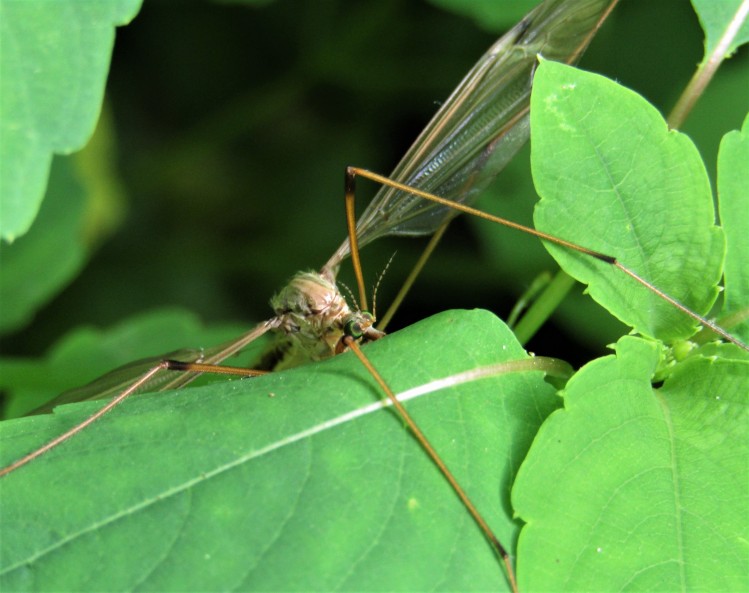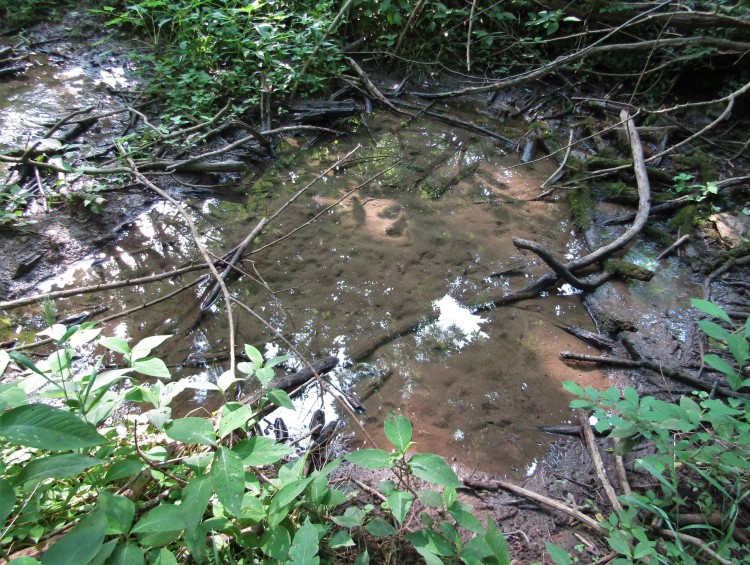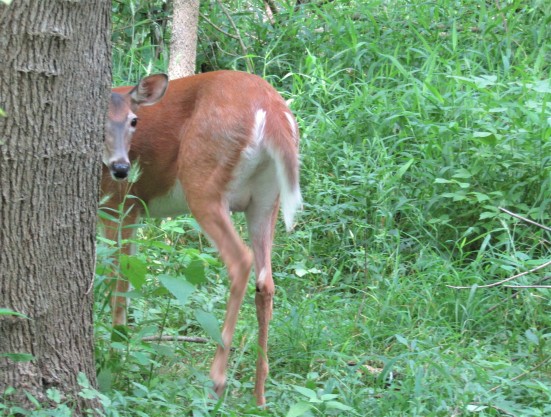
It’s Browntail again, and she has a little secret. Yesterday she was acting oddly skittish, and I sensed she really wanted me to go away – probably because it was time to feed her new fawn(s). I haven’t seen them yet, but she has an udder full of milk and she’s looking skinny again.
This is how it is in early summer – every living thing is busy making more of itself. An exposion of fecundity in a system that demands great excess – you’re born then you’re eaten.
Me, the observer, thankfully not on anyone’s menu except for mosquitos (this forest has no ticks) as I skulk about with my camera, seeking more evidence of revival.

Limestone Wild Petunia, Ruellia strepens, one of the loveliest flowers I know, is making the most of increased light and deer distaste. It appears to spread easily from seed, and is repopulating trailside and in newly sunny gaps.

The incredibly long-legged Crane Fly, genus Tipula, lives only two weeks as an adult. When females pupate, they have fully developed eggs and seek to mate right away. Despite the shrieks and arm-waving they provoke, the adults don’t bite or even eat. Larvae are the eaters, and spend their lives recycling organic matter in wet soil.

When a tree falls in the forest – a deer rushes over to see what’s growing on it that was previously out of reach. A vigorous Virginia Creeper vine, Parthenocissus quinquefolia, growing on a fallen tree is choice browse, judging by all the clipped stems.

The shed skins of the Black Rat Snake, Pantheropsis obsoleta, are surprisingly common in the forest. It’s evidence of healthy populations of this very long snake, which scares the pants off hikers who encounter it on the trail. A forest friend of mine saw one last week, laying by the trail with cloudy eyes, unwilling to move. It was in a vulnerable state, barely able to see as it prepared to molt. Rat snakes are great climbers and hitch right up tree trunks in search of bird nests.

As the commonest of birds, Robins get little respect. They’re very abundant in the forest now – nesting, skirmishing over territory, bathing in the spring-fed streams, eating mulberries and insects. Their services will be needed this fall when the Spicebush berries ripen. With much less Bush Honeysuckle available, hopefully Robins will gorge on the high-lipid Spicebush fruits. Bird dispersal seems to be working well, since hundreds of new little Spicebush are popping up, especially in the vicinity of mature berry producing shrubs.

Speaking of Spicebush, do you know why this leaf is curled so oddly? I spotted it yesterday in a Spicebush grove. Inside someone was hiding on it’s leaf-bending web.

The season’s first generation of Spicebush Swallowtail butterflies has come and gone already, and this fat eye-spotted caterpillar is almost ready to pupate. Researchers believe the facial pattern of the mature larva has evolved as a mimicry of a green snake or tree frog. It’s mind-boggling to think how many billions of generations of Spicebush caterpillars had to come and go, each one minutely tweaked by the eye of a beholder bird.

In the one precious little salamander breeding pool in this forest, a few larvae with gills still hang out. Judging by all the raccoon tracks in the mud, their numbers have been whittled down.

The larva in the pic above may be a Streamside salamander, Ambystoma barbouri, which has a small range centered in the Ohio River valley. Here’s a link to a great piece on the hazards of life for salamanders. “Spring Salamander Gauntlet: Avoiding Raccoons, Sexual Parasitism, and Suburban Sprawl” http://beltmag.com/16200-2/
A great project for this largely bottomland forest would be the construction of true ephemeral pools that hold water through the summer. Though there’s plenty of standing water in winter and early spring, it dries up quickly just about the time when larvae would be hatching.

As a parting shot, I’m sharing this bird splat pic, since it tells a story. If you’re walking in the forest, and hear robins and other songbirds making a great fuss, it’s likely there’s a hawk or owl about. I encountered such a fuss-fest last week along the trail, and as I looked about for the reason, this large liquid-y ejection barely missed me. Looking up, I had a great view of the underside of a Red-shouldered Hawk perched just above.

Marianna metcalf
Wonderful little trip as seen through the eyes of an expert and wonderful storyteller.
LikeLike
oneforestfragment
Thank-you Mariana, your praise will be hard to live up to!
LikeLike
Conrad Selle
We have seen a new fawn at Calvary in sections 15 , 16, and 18 twice this week. Don’t know if Mommy Deerest is there or on the other side of the perimeter fence. Lots of shrubberies in 15.
________________________________
LikeLiked by 1 person
oneforestfragment
Mommy deerest!! Hope they’re better mothers than she was.
LikeLike
tonytomeo
Is that a native red mulberry that the robin is in? I have seen them growing wild only once. They are not native here. Exotic black mulberries used to grow on the perimeters of orchards to keep birds occupied while the fruit ripened inside the orchard. When the orchards were developed into neighborhoods, a few of the black mulberries sometimes survived on the edges of the roads.
LikeLike
oneforestfragment
Mulberries certainly do keep birds occupied! It’s been a big party for the robins in this forest the last few weeks. The pic is a White Mulberry, which commonly has black, somewhat tasteless berries when ripe. The Red mulberry has larger leaves, which are rough hairy on top, and bigger sweeter berries.
LikeLiked by 1 person
tonytomeo
Oh, I did not recognize it. The fruitless mulberry, which is a cultivar of white mulberry, is still a common ornamental here, even though the fruiting types are now rare. When I get a mulberry of choice, I want a North American native red mulberry. I normally prefer the cultivars that traditionally grew in the Santa Clara Valley, but the mulberries were so variable, and I did not like many of them anyway. (A cultivar like ‘Pakistan’ was the most common, but there were a few others. There might have been white or red mulberries. Some were probably selected because their fruit was ready at about the same time as the fruit they were there to distract the birds from.)
LikeLike